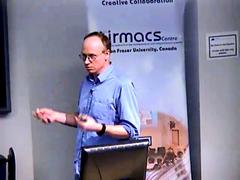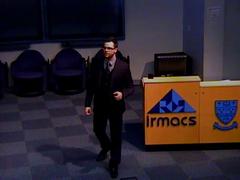As the IRMACS Thematic 2011 year wraps up we explore what we've learned about Scientific Modelling at Simon Fraser University.
IMC Colloquium Series
Past IMC Colloquium Presentations
Friday, December 2, 2011
Wednesday, November 23, 2011
Mike Steel directs the Biomathematics Research Centre, and is Professor in the Mathematics and Statistics Department of University of Canterbury, Christchurch, New Zealand. He is the deputy director (2009-), and a founding principal investigator of the Allan Wilson Centre for Molecular Ecology and Evolution. He is also an elected fellow of the Royal Society of New Zealand, and is an Associate Editor (2009-) of IEEE/ACM Transactions in Computational Biology and Bioinformatics, and is on the editorial boards of Journal of Computational Biology and Evolutionary Bioinformatics.
Friday, September 23, 2011
Many criminal street gangs are territorial in nature claiming compact geographic regions as their home turf. Gangs defend their territories both with the threat and use of violence. A neutral model based on spatial Lotka-Volterra competition equations shows that territories are strictly stable only where gangs are exactly symmetrical in all characteristics, which we interpret as a neutral condition. We test the model against data on violent crime involving thirteen street gangs in a region of Los Angeles. We find excellent agreement between model predictions and the observed spatial distribution of crime.
Friday, September 9, 2011
The world is ready for University 2.0. We have been delivering 1.0 - traditional university education - for over one thousand years now. However, we are clearly failing to meet the need for adequately trained health workers, as we are lacking four million health workers according to World Health Organization globally, and over one million in Africa alone. Dr. Kate Tairyan, MD, MPH, Senior Lecturer at the Faculty of Health Sciences will present her work on NextGenU - the world's first free university. She will outline the transformative model of delivering high quality education with competency-based online curriculum plus community-based...
Friday, April 1, 2011
The case-parent trio design was popularized by the well-known transmission-disequilibrium test, which conditions on parental genotype information at a test locus to make inference about genetic association that is robust to population stratification. The TDT considers alleles transmitted to the affected offspring (case) as well as those not transmitted (pseudo-controls). The availability of pseudo-controls has lead to a popular belief that the case-parent design itself is robust to population stratification. While this may be true for tests of genetic main effects, some caution is required when extending to inference of gene-by-...
Friday, March 18, 2011
In 1936, Keynes drew an analogy between investing in the stock market and predicting the winner of a beauty contest, where the winner is the contestant who is most often selected by others. Since everyone knows that everyone else is trying to predict average opinion, an infinite regress ensues. Keynes argued that markets are bound to be volatile when average opinion itself becomes the object of speculation.
Formalizing Keynes' metaphor has been difficult, as it leads to infinite dimensional fixed point problems. This talk will discuss how frequency domain methods can be used to solve these problems. Evidence is presented that...
Friday, March 4, 2011
One of the key contributors to the spread of the HIV epidemic is the prevalence of risk behaviour, such as unprotected sexual contact and the sharing of infected hypodermic syringes, within the susceptible population. We assume that risk behaviour is a social phenomenon and that the propensity of any given individual to engage in such behaviour depends on the norms within their social environment. The likelihood of any given susceptible individual engaging in risky behaviour then becomes a function of the prevalence of risk behaviour in their immediate social group. In this view, behavioural interventions could target either the frequency...
Friday, February 11, 2011
By using parameterization techniques which model the knowledge space of a living or cognitive systems (eg. the behavior space of whales, the expression space of faces) it is possible to use Artificial Intelligence techniques such as Neural Networks and Genetic Programming to create new types of expression systems for use in communication, learning, interactive games and digital media systems. Steve DiPaola will discuss and demonstrate his work in this area (see ivizlab.sfu.ca). Best known for his expertise in AI based 3D facial and avatar systems, DiPaola will demonstrate iFace research which uses a parameterized approach to synthetic...
Friday, January 21, 2011
A promising avenue for law enforcement agencies to have an impact on drug trafficking networks is to focus on the most important actor, the one that is least likely to be in abundant supply: the "key player". It is the one that, if removed, will produce the most destabilizing impact in a trafficking network. Identifying this key player is a challenge in itself. In this paper, the key player is defined as one of the many positions that illegal drug market participants may occupy, from importer to retailer. The individual drug trafficking networks of 187 incarcerated drug market participants active at different positions in are brought...








